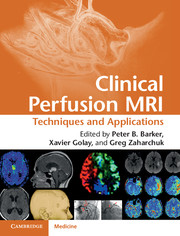Book contents
- Frontmatter
- Contents
- List of Contributors
- Foreword
- Preface
- List of Abbreviations
- Section 1 Techniques
- 1 Imaging of flow: basic principles
- 2 Dynamic susceptibility contrast MRI: acquisition and analysis techniques
- 3 Arterial spin labeling-MRI: acquisition and analysis techniques
- 4 DCE-MRI: acquisition and analysis techniques
- 5 Imaging of brain oxygenation
- 6 Vascular space occupancy (VASO) imaging of cerebral blood volume
- 7 MR perfusion imaging in neuroscience
- Section 2 Clinical applications
- Index
- References
5 - Imaging of brain oxygenation
from Section 1 - Techniques
Published online by Cambridge University Press: 05 May 2013
- Frontmatter
- Contents
- List of Contributors
- Foreword
- Preface
- List of Abbreviations
- Section 1 Techniques
- 1 Imaging of flow: basic principles
- 2 Dynamic susceptibility contrast MRI: acquisition and analysis techniques
- 3 Arterial spin labeling-MRI: acquisition and analysis techniques
- 4 DCE-MRI: acquisition and analysis techniques
- 5 Imaging of brain oxygenation
- 6 Vascular space occupancy (VASO) imaging of cerebral blood volume
- 7 MR perfusion imaging in neuroscience
- Section 2 Clinical applications
- Index
- References
Summary
Introduction
Tissue oxygenation is a critical physiological parameter in most organ systems. In the brain, oxygenation status plays an important role in hypoxic and ischemic injuries, carotid artery disease, and tumor growth and response to therapy. Traditionally, positron emission tomography (PET) has been used to measure brain oxygen metabolism, but more recently the feasibility of measuring brain oxygenation with MRI has been explored [1–6]. This chapter discusses the theory and methodology of several approaches for measuring brain tissue oxygenation using MRI, including quantitative blood oxygenation level-dependent (qBOLD), quantitative susceptibility mapping (QSM), and T2 relaxation under spin tagging (TRUST). Additional detail, particularly more technical aspects, can be found in a recent review article [7]. Before delving into these methods, we will present a brief review of cerebral autoregulation as it affects oxygenation measurements.
Theory
Cerebrovascular autoregulation and oxygenation measurements
When an artery becomes narrowed or completely occluded, the mean arterial pressure (MAP) in the distal circulation may fall, depending on both the degree of stenosis and the adequacy of collateral sources of blood flow [8]. If collateral flow is inadequate, MAP will fall, leading to a reduction in cerebral perfusion pressure (CPP), which is defined as the difference between MAP and venous backpressure.
- Type
- Chapter
- Information
- Clinical Perfusion MRITechniques and Applications, pp. 75 - 88Publisher: Cambridge University PressPrint publication year: 2013
References
- 2
- Cited by



